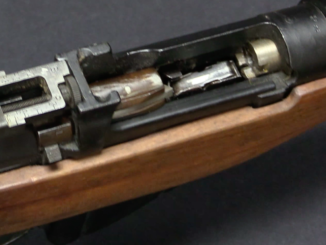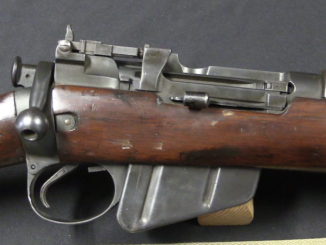This rifle sold for $5,175 at Rock Island on December 2, 2018.
In 1943, the British government began a program to develop a shortened and lightened version of the No1 SMLE rifle, for production in India and Australia – where the national ordnance factories had not converted to production of the No4 rifle. This prototype is the first pattern produced by the Ishapore Arsenal for testing. Its barrel is cut down to 16.5 inches (plus a 2.8 inch long conical flash hider), it has a unique 3-position flag style of rear aperture sight, and has had its sling swivels repositioned. This rifle was tested in the UK, and some modifications were recommended. A second pattern from Ishapore was then provisionally approved as the No6 MkI on September 1st, 1944, but cancelled before production could begin. The Australian pattern of No6 was approved a year late in September 1945, but then declared obsolete before it could be put into production. With the end of World War Two and Indian independence in 1947, the funding and impetus for a new short rifle were lost, and instead Ishapore would end up converting its production to No1 pattern rifles in 7.62mm NATO a few years later.




I have a Jungle Carbine that is “correct” for all the features it should have except for the finish which is blued and that it is marked Ishapore. It is definitely not a commercial chop job. I actually bought it thinking it was a chop job and paid commensurately. Either the Indian government received it from the British and scrubbed markings and refinished it, or this could be an example of actual Indian production
Is it marked “RFI”? I also have a correct No 5, but which is marked RFI. I think they refurbed them and remarked them.
I am intrigued by the rear sight set up…it is a creative set up. How sturdy would it be in a jungle enviroment? Is it sturdy enough to prevent foliage from resetting adjustments?
I still regularly hunt deer, goat, wild pigs and camel and that covers open desert country to dense eucalypts scrub and the sights serve me well. Under 200 yards they stay folded down and it is rarely you see game over 50yards away in dense bush. However the recoil can be pretty mean on snap shot.
Craig, Australia.
Do you have a No6 Ishapore carbine like the one in the video? Or is it an Australian pattern No6?
Thanks in advance!
Amazing, I have had it 40 years and it was just JC. I have just looked at it critically and it is the no5 mk1, I think from Australia. It has different marking to the No5 mk1 in the other explanatory video, the one where he shoots it. It does look the same with the receiver cut outs etc. it has electro pencil sign on the side No5 mk1 4/45 so it was one of the last made. Very rare, ONLY 250,000 made!
It does not have zero wander as I use hand loads which are a bit lighter as i need accuracy not power, it will knock over anything inside 100m with ballistic tip 150g projectiles.
Interesting! If is a No5 Mk1, it must have been made at ROF in Fazakerley, Liverpool, or by BSA.
The Australian version was made in very small numbers (No6MkI and MkI/I), and it was derived from the SMLE.
You are right it has ROF (F) in electro pencil on the action. It must be one of the most common type, just ended up in Australia some how. Hard to understand as everything here seems to come from the Lithgo armoury.
All the same a very handy scrub gun on pigs, where you need to sure of every shot.
That’s awesome! Thanks for sharing your experience with these carbines.
Australians were using No 5’s in the “Malayan Emergency” (1948-1960) in what is now Malaysia. I think many ended up in Australia post WWII.
Very interesting about Malaysia, it makes sense regarding how it got to Australia.
The Australian No.6 carbine was not entirely abandoned in c.1945. When the 7.62 NATO cartridge was adopted, a number of No 6 carbines were later rebarelled for the 7.62×51 mm cartridge and a 20 round L1A1 magazine was added. These rifles were supposedly to be issued to the Royal Australian Air Force (RAAF) security detachments. However, trials with the No 6 rifles indicated that the receivers which were SMLE No 1 Mk III* and used for the No 6 Carbines stretched too much and it was determined that the receivers could not cope safely with the 7.62 conversions due to the higher pressures. These tests were then abandoned and the RAAF ended up with the L1A1 main battle rifles.
Clever rear sight. Allows for a longer sigh radius in spite of the abbreviated barrel. The Soviets lopped fully nine inches off the 1891/30 vintovka for about a 20-inch barrel on the M44 (urban)jungle carbine. Quite a hefty muzzle flash and loud too! Apparently the designers were not as troubled with reducing it as UK/Commonwealth/British Colony technicians. 16 inches you say?! If I had to lug something through the jungle, that carbine would be it. If I had to be confident I could preserve my buddies’ lives as well as my own, I’d want an Owen SMG! Of course I think two of those carbines might not match the weight of one of those?
That sight design looks like it could have been retrofitted to just about any bolt action design with tangent sights?
Odd- something changed on the format. No view counter, and no “thumbs up/thumbs down” buttons.
Several years ago I purchased an Ishapore Enfield rifle that had supposedly been manufactured in 7.62 NATO. I have not shot it a lot but when it did I was completely satified with it’s accuracy. In shooting a box of commercial white box .308 I noticed no indication of trouble. After reading the above comment concerning a No. 6 converted to 7.62 I wonder if my rifle might suffer from the same issues. Did India put new receivers on these rifles when the chambering was switched to 7.62 NATO?
The Australian No 6 carbine has no association with the Indian No 6 carbine. The assumption would indicate that the metallurgy of the Indian No 6 may have been different to the Australian pattern.
The SMLE version manufactured by Ishapore in 7.62 NATO (2A1) got new receivers, with superior metallurgy. Please note that the 2A and 2A1 rifles were newly manufactured, not conversions of extant .303 SMLEs. In order to withstand the increased chamber pressure generated by the 7.62 NATO round, Ishapore made the receivers of the 2A and 2A1 rifles from a high quality steel, with modern heat treatment.
Everyone I spoke to who either owns or at least has tried a 2A1 Ishapore SMLE in 7.62 NATO, with a good barrel, has confirmed its inherent accuracy.
Some prototype and/or limited production post war Canadian sniper rifles had a similar rear sight.
Wow, fascinating! I had no idea. Thanks for that.
Ian, thank you for the many videos. Short notice, but I just stumbled across an auction of a number of firearms from the collection of Mark Aziz offered by Cowan’s Auctions: Artemus Wheeler revolving flintlock, Wilkinson Experimental Percussion Under Hammer Military Musket, Porter Turret Musket,…
https://www.bidsquare.com/online-auctions/cowans/porter-turret-musket-1225418